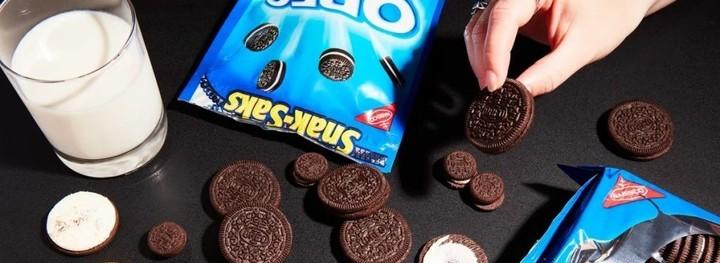"Twist, lick, bubble", Oreo's advertising slogan can be said to be a household name. Even every time I eat Oreo, I habitually want to twist it away and take a look.
In the eyes of many people, the twisted Oreo is just an ordinary sandwich cookie, but in the eyes of these researchers, Oreo still contains many "mysteries".

Image courtesy of Best Products
When eating Oreo, have you ever wondered why the sandwich cream in the middle always stays only on the side of the cookie when twisting Oreo?
A team of researchers at MIT (Massachusetts Institute of Technology) had a question after rigorous material testing of this sandwich biscuit: Why does the cream of the biscuit only stick to one piece when it is twisted?
▲ Image courtesy of AIP Publishing
The seemingly non-flowing cream in the middle of Oreo is actually a non-Newtonian fluid. For some non-Newtonian fluids, when the applied shear stress is small, the fluid only deforms and does not produce flow, and the fluid begins to flow when the shear stress increases to a certain value, and Oreo's cream belongs to this category.
Twisting Oreo apart is actually a test that mimics rheology—studying how a non-Newtonian material flows under twisting, squeezing, or other pressures. Therefore, the research team actually conducted a study on the deformation and flow of objects under the action of external forces.
▲ Image courtesy of AIP Publishing
To find out, the team ran standard rheological tests on the biscuits in the lab and found that no matter what the taste and how much of this cream in the middle of Oreo was, it almost always stuck to a piece of the biscuit when twisted open. Only for older boxed biscuits, the cream is sometimes more evenly distributed across the two biscuits.
▲ Image courtesy of Sided
In this finding, the researchers wanted to learn more about what exactly caused this effect; if orio was carefully placed on a rheometer, would it be possible to control the distribution of cream?
▲ Image from: Unsplash
For further research outside the lab, the researchers developed an Oreo separation device, the Oreometer, a 3D printed torsion testing device designed for Oreo and similarly sized round objects that do not require power or electronics, cost $6 (including coins and rubber bands), and can be used extensively.
Place Oreo between the two clips in the "Oreometer" and use the rubber band on the clip to adjust the torque on the wafer. When the coin is added to one side, the clip rotates to separate the cookies.
▲ Image from: Gizmodo
Using the "Oreometer" for about 20 boxes of Oreos of different flavors and forms (such as chocolate-flavored, double-layered...). After applying varying degrees of torque and angle rotation and recording the distribution of the cream, they found that how much or how much the cream tasted did not affect how it always dispersed over a slice of cookie.
While no perfect way to control the distribution of cream when twisting Oreo is not yet found, researchers have a conjecture that this phenomenon may be related to Oreo's production process.
▲ Image courtesy of AIP Publishing
Crystal E. Owens, who is conducting research related to 3D printing, said: "My 3D printing liquid and Oreo cream are the same kind of material. So when I'm trying to print flexible electronics with carbon nanotube mud, this new realization can help me design inks better because they're almost identically deformed."
▲ Image from: GitHub
The research team published an article about the study in the journal AIP Publishing, and it is worth mentioning that the "Oreometer" design information is also open sourced and placed on the GitHub website, so anyone can build their own device and collect data about the separation of Oreo. Maybe in your device, you can separate Oreo perfectly.